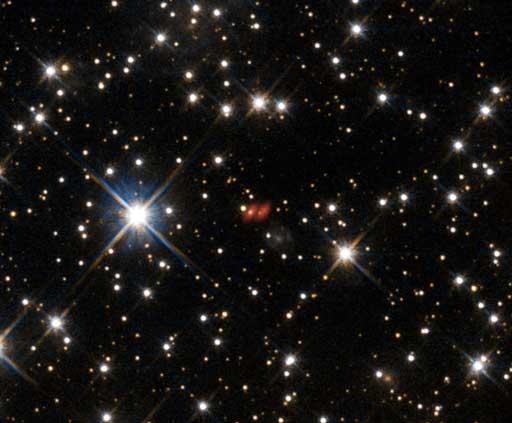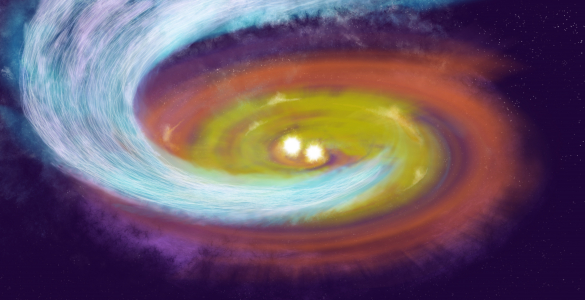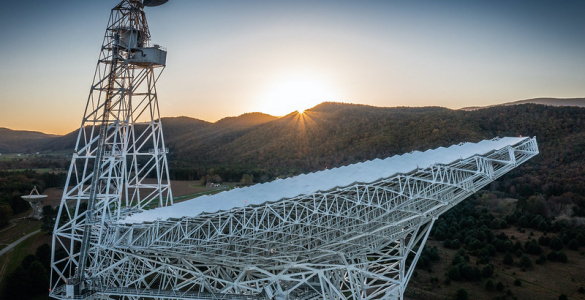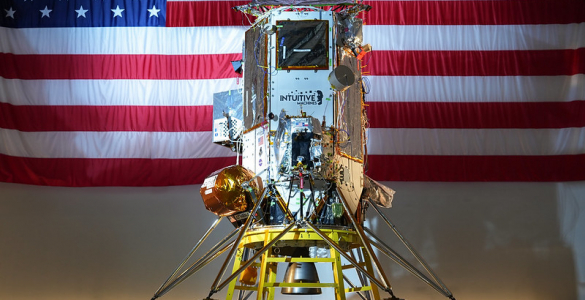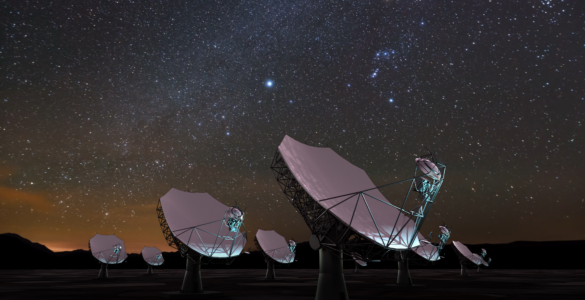Two teams of researchers using the Atacama Large Millimeter/submillimeter Array (ALMA) telescope have made remarkably detailed observations of supermassive black holes caught in the act of ingesting matter and converting it into powerful jets of particles and energy. Both results were published in the journal Astronomy and Astrophysics.
In the first paper, astronomers aided by a giant cosmic lens – a massive galaxy that bends and focuses light emitted by more-distant objects – studied a far-flung supermassive black hole known as a blazar. They were surprised to discover this object was simultaneously emitting longer wavelength light, as seen with ALMA, and gamma-ray pulses, as observed with the Fermi-LAT satellite.
The concurrent flare-ups suggest that the same process was responsible for generating both low-energy millimeter light and high-energy gamma-rays.
“The nature of a blazar is that there is a relativistic [near light-speed] jet that is pointed at us. ALMA has allowed us to ‘look down its barrel,’ so we’re able to see very close to the base of the jet into the region where the action is happening.” said Jeremy Darling, an astrophysicist with the University of Colorado in Boulder and coauthor on the paper. The team was led by Ivan Martí-Vidal, a researcher at Chalmers University of Technology, in Onsala, Sweden.
When material falls inward on giant black holes, which reside at the centers of nearly all galaxies, most of it is gulped up, but a small fraction is kicked out in jets that accelerate subatomic particles to nearly the speed of light.
The ALMA observations captured this object, dubbed PKS 1830-211, which is approximately seven billion light-years from Earth, at this precise moment it was ingesting material and blasting it out into the cosmos. The presence of the intervening gravitational lens and ALMA’s high resolution and sensitivity allowed the researchers to conduct observations along the length of the jet, to an area astonishingly close to the black hole.
“The ALMA observation of this case of black hole indigestion has been completely serendipitous. We were observing PKS 1830-211 for another purpose, and then we spotted subtle changes of color and intensity among the images of the gravitational lens. A very careful look at this unexpected behavior led us to the conclusion that we were observing, just by a very lucky chance, right at the time when fresh new matter entered into the jet base of the black hole,” says Sebastien Muller also at Chalmers University and a co-author of the paper.
“This is the first time that such a clear connection between gamma rays and sub-millimeter radio waves has been established as coming from the real base of a black hole’s jet. Future observations of this black hole using this strategy may allow us to learn more details about the activity of a supermassive black hole, and how the material in the powerful jet is being launched,” says Martí-Vidal.
In the second observations, ALMA revealed a surprising spiral structure in the molecular gas close to the center of galaxy NGC 1433.
According to Françoise Combes (Observatoire de Paris, France), the lead author of the second paper, “this explains how the material is flowing in to fuel the black hole. With the sharp new observations from ALMA, we have discovered a jet of material flowing away from the black hole, extending for only 150 light-years. This is the smallest such molecular outflow ever observed in an external galaxy.”
The discovery of this outflow, which is being dragged along by the jet from the central black hole, shows how material can be removed from a galaxy. This process can stop star formation by removing the raw materials for the next generation of stars. It can also regulate the growth of the central bulges of galaxies.
“Thanks to ALMA’s power, this is among the sharpest such pictures ever made of a black hole that is actively feeding on a surrounding disk of material and converting it to electromagnetic radiation,” said co-author Andrew Baker of Rutgers, the State University of New Jersey. “The feeding process is closely related to a high-velocity wind driving gas out of the center of the galaxy.”
The National Radio Astronomy Observatory is a facility of the National Science Foundation, operated under cooperative agreement by Associated Universities, Inc.
ALMA, an international astronomy facility, is a partnership of Europe, North America and East Asia in cooperation with the Republic of Chile. ALMA construction and operations are led on behalf of Europe by ESO, on behalf of North America by the National Radio Astronomy Observatory (NRAO), and on behalf of East Asia by the National Astronomical Observatory of Japan (NAOJ). The Joint ALMA Observatory (JAO) provides the unified leadership and management of the construction, commissioning and operation of ALMA.
Contact:
Charles E. Blue
(434) 296-0314
cblue@nrao.edu








